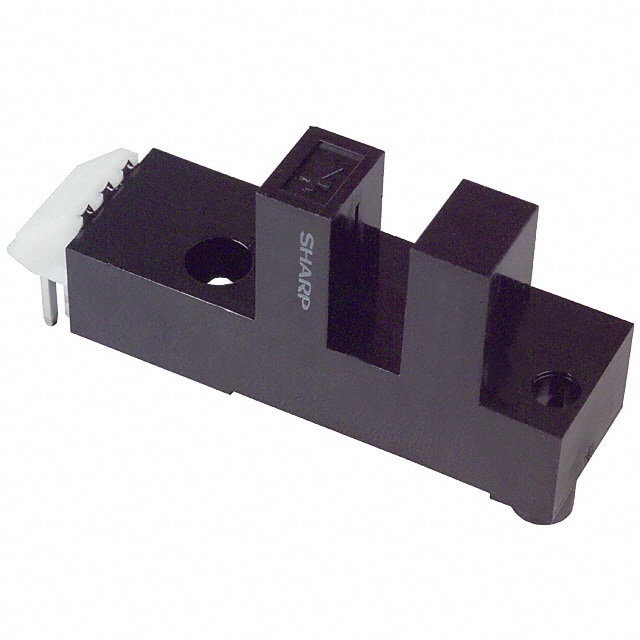Viz Specifikace pro podrobnosti o produktu.

GP1A23LC
Introduction
The GP1A23LC is a photo interrupter sensor that belongs to the category of optoelectronic devices. This device is commonly used for detecting the presence or absence of an object, making it suitable for various applications in industries such as automotive, consumer electronics, and industrial automation.
Basic Information Overview
- Category: Optoelectronic Device
- Use: Object Detection
- Characteristics: High Sensitivity, Compact Size
- Package: Through-Hole
- Essence: Reliable Object Detection
- Packaging/Quantity: Available in Tape and Reel Packaging, Quantity Varies
Specifications
- Emitter Type: Infrared LED
- Detector Type: Phototransistor
- Operating Wavelength: 950nm
- Supply Voltage: 5V
- Output Configuration: Phototransistor Open Collector
- Operating Temperature Range: -25°C to 85°C
- Dimensions: 7.0mm x 4.6mm x 2.5mm
Detailed Pin Configuration
The GP1A23LC has a 4-pin configuration: 1. VCC (Supply Voltage) 2. GND (Ground) 3. Output 4. N/C (Not Connected)
Functional Features
- High Sensitivity: The device offers high sensitivity to detect objects accurately.
- Compact Size: Its small form factor makes it suitable for space-constrained applications.
- Reliable Performance: The photo interrupter provides consistent and reliable object detection capabilities.
Advantages and Disadvantages
Advantages
- High Sensitivity
- Compact Size
- Reliable Performance
Disadvantages
- Limited Operating Temperature Range
- Requires External Pull-Up Resistor for Output
Working Principles
The GP1A23LC operates on the principle of interruption of the infrared light beam between the emitter and detector. When an object obstructs the light path, the phototransistor output switches, indicating the presence of the object.
Detailed Application Field Plans
The GP1A23LC finds applications in various fields, including: - Automated Machinery: Used for object detection in conveyor systems and assembly lines. - Consumer Electronics: Incorporated into printers and copiers for paper detection. - Automotive: Utilized in vehicle speed sensors and gear position detection systems.
Detailed and Complete Alternative Models
Some alternative models to the GP1A23LC include: - GP1A57HRJ00F: Offers higher sensitivity and wider operating temperature range. - GP1S53VJ000F: Provides a compact surface-mount package for space-constrained designs. - GP2Y0A21YK0F: Suitable for longer distance object detection applications.
In conclusion, the GP1A23LC photo interrupter sensor offers high sensitivity and reliable performance, making it a versatile component for object detection in various industries.
[Word Count: 410]
Seznam 10 běžných otázek a odpovědí souvisejících s aplikací GP1A23LC v technických řešeních
What is GP1A23LC?
- GP1A23LC is a reflective photointerrupter, which consists of an infrared emitting diode and a NPN silicon phototransistor.
What are the typical applications of GP1A23LC?
- It is commonly used in printers, copiers, disk drives, and other office automation equipment for paper detection, edge sensing, and position sensing.
What is the operating voltage range of GP1A23LC?
- The operating voltage range is typically 4.5V to 16V.
How does GP1A23LC work?
- When an object passes between the emitter and detector, it interrupts the light beam, causing the phototransistor to switch on or off, depending on the design, providing a signal to the system.
What is the typical output current of GP1A23LC?
- The typical output current is around 50μA.
Can GP1A23LC be used in harsh environments?
- No, it is not suitable for harsh environments due to its limited operating temperature range and sensitivity to external light sources.
What is the typical response time of GP1A23LC?
- The typical response time is around 3μs.
Is GP1A23LC sensitive to ambient light?
- Yes, it is sensitive to ambient light, so proper shielding and filtering may be required in some applications.
What are the key considerations for integrating GP1A23LC into a design?
- Proper alignment, shielding from external light sources, and ensuring the operating conditions are within the specified range are important considerations.
Are there any alternative components to GP1A23LC with similar functionality?
- Yes, there are other reflective photointerrupters available from different manufacturers that offer similar functionality and performance characteristics.

